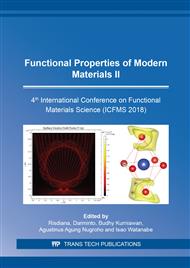p.66
p.72
p.77
p.83
p.89
p.95
p.100
p.107
p.119
Particle Size Analysis of the Synthesised ZrO2 from Natural Zircon Sand with Variation of pH Deposition Using Alkali Fusion-Coprecipitation Method
Abstract:
Zirconia (ZrO2) is one of the refractory ceramic materials that have applications in several fields. The aim of this study was to synthesis ZrO2 from natural zircon sand collected from Kereng Pangi, Central Kalimantan with a variation of pH deposition using alkali fusion co-precipitation method. The synthesized ZrO2 began with the preparation process involved magnetic separation, milling, and leaching with HCl. Furthermore, the alkali fusion process was used KOH solution and heated in an electrical furnace at 700°C for 3 h whereas the co-precipitation process was carried out using a filtrate mixed with the NH4OH solution to reach a pH variation between 3–11 and then precipitated for 12 h. The precipitates were dried in an oven and then calcined at 800°C for 3 h. The structure of synthesized ZrO2 was characterized using XRD and the particle sizes were measured using particle size analyzer (PSA). The XRD analysis showed that the identified phase of zirconia powder is tetragonal with a crystal size in nanometer size. Result of PSA measurement revealed that the crystal size decreased in the range pH of 3 - 7, but increased in the range pH of 7 - 11. The biggest powder particle size could be achieved at 260 nm with pH 7 whereas the smallest size was at 143 nm occurred at pH 3.
Info:
Periodical:
Pages:
89-94
Citation:
Online since:
August 2019
Keywords:
Price:
Сopyright:
© 2019 Trans Tech Publications Ltd. All Rights Reserved
Share:
Citation:


